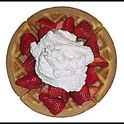Scoring bread dough
Why do most some recipes say to score the dough before the final rise? It's worked well for me, and I'm always a little scared my dough will collapse when I score it, so why not always do it before the final rise?
11 Comments
boulangereApril 24, 2012
Whichever pattern you choose - long or diagonal - be certain that you are holding your blade at an acute angle, not vertically. The physics of the skin, for hearth loaves certainly, are such that if you score at an acute angle, the edges will both remain separate and also move away from each other, which is what you want to happen. If scored vertically, they tend to want to seal closed again. Too, I would suggest never scoring bread other than just before placing in the oven. Once you score it, you've opened pockets of carbon dioxide which have formed within your pockets of gluten. You want to get the bread into the oven immediately thereafter so that the crust can begin to form, which will seal the slashes and give you that great oven spring.
ReineyApril 24, 2012
If you mean 3 diagonal vs. 1 long slash - no, the scoring pattern is purely aesthetic. There is some science behind depth of scoring, and even scoring (you want to cover all parts of the bread to ensure even oven spring - so the end of the last diagonal is even with where you start the next one).
If you're very interested in bread science I can highly recommend the book called "Bread Science: The Chemistry and Craft of Making Bread" by Emily Buehler. It can be hard to track down, but it's an excellent and thorough investigation into the whys & methods of bread baking.
:)
If you're very interested in bread science I can highly recommend the book called "Bread Science: The Chemistry and Craft of Making Bread" by Emily Buehler. It can be hard to track down, but it's an excellent and thorough investigation into the whys & methods of bread baking.
:)
softpunkApril 23, 2012
Thanks so much to Boulangere and Sarah.Reinertsen for their detailed answers.
I decided to make 3 loaves, 1 scored before the final rise, and 2 scored right before being popped in the oven -- 1 had a long slit straight along the loaf, and the other slashed 3 times diagonally. While the pre-rise scoring has worked great for me with Lapadia's Country Loaf (http://food52.com/recipes...), it wasn't the way to go with Boulangere's Italian bread. The scoring didn't stay crisp, and the loaf didn't rise as well.
While both the 3 diagonal and single long slash loaves rose well, I wonder if there's any reason other than aesthetic to use one method over the other. Could one method in theory create a taller vertical rise?
I decided to make 3 loaves, 1 scored before the final rise, and 2 scored right before being popped in the oven -- 1 had a long slit straight along the loaf, and the other slashed 3 times diagonally. While the pre-rise scoring has worked great for me with Lapadia's Country Loaf (http://food52.com/recipes...), it wasn't the way to go with Boulangere's Italian bread. The scoring didn't stay crisp, and the loaf didn't rise as well.
While both the 3 diagonal and single long slash loaves rose well, I wonder if there's any reason other than aesthetic to use one method over the other. Could one method in theory create a taller vertical rise?
ChrisBirdApril 18, 2012
Oh, and I have discovered that the old fashioned double edged raor blades are the perfect devices for scoring. I had a lame - it got dull quite quickly and seems to be pricy compared to $5.49 for 10 double edged razor blades from my pharmacy.
boulangereApril 18, 2012
The poke test works for any dough. But pay attention to the dough - whole-grain doughs tend to proof more slowly than non-whole-grain.
boulangereApril 18, 2012
The principal reason to score bread before baking is to encourage it to expand in the direction in which YOU want it to travel. The last gasp of dough in the oven, that you can literally watch, is known as "oven spring." It is the final expansion of compartments of C02 within the dough, and the expansion you want to direct. The rule of thumb is that if you don't give dough a direction in which to expand, it will find its own. In sum, scoring dough serves two purposes: it directs the expansion of dough, and it results in a beautiful appearance. As to when to score dough, the answer is the same as when it is appropriate to transfer bread dough to the oven, or even when you should shape dough after its initial proofing: when you can gently press a finger into the dough (and I do mean GENTLY) and the imprint remains, the dough is ready for the next step, be it shaping or scoring + baking. If the dough springs back immediately, it needs additional proofing time (set a timer for 15 minute increments). There are many, many scoring tools available to slash bread. I own them all. And I always return to a serrated knife. Score your bread a good 1/2" deep. Don't open the oven during the first 10 minutes, because that is the time during which the oven heat is raising water molecules to steam, and simultaneously quickly raising the dough. If you haven't over proofed your dough, you'll get a great oven spring. You'll not have over proved your dough if you get a decent indentation, but not a sigh, when you gently poke your dough. I always advise that bakers begin preheating the oven when the dough is shaped for its final proof, then set a timer for 30 minutes to give the dough the poke test. It is very easy to add 5 minutes to any timer. It is very difficult to un-proof dough, or to un-bake bread. Does this help you?
ChefOnoApril 18, 2012
It helps me. The science I understand, I'm still working on the art. This poke test, is it appropriate for any type of dough or are there exceptions?
ChefOnoApril 18, 2012
I meant to write:
It helps me, thank you. The science I understand, I'm still working on the art. This poke test, is it appropriate for any type of dough or are there exceptions?
ReineyApril 17, 2012
Keep doing what you're doing then, if it works for you :)
That's the theory behind it. There are times when we'd snip shapes into bread rolls before the final rise, but the scoring isn't as pronounced in the final product. It likely also depends on the bread dough and how firm/weak the dough structure is, and whether the dough was over-proofed, under-proofed or just right.
That's the theory behind it. There are times when we'd snip shapes into bread rolls before the final rise, but the scoring isn't as pronounced in the final product. It likely also depends on the bread dough and how firm/weak the dough structure is, and whether the dough was over-proofed, under-proofed or just right.
ReineyApril 17, 2012
A key to a good shape in bread is the taut surface formed by gluten structure. The final rise fills the final shape - a tight boule or bread loaf, etc. If you were to score it ahead of the final rise, the bread would end up misshapen/lopsided.
Scoring serves the purpose of decoration/baker's signature, but it also creates a weak spot to help the dough expand when baking. (Otherwise the dough could rip in another spot when it goes into the oven).
You want to wait until the last possible moment to score the bread, and put it into the oven straight away.
The act of putting the bread dough into the oven creates one last dance for the yeast - and this is when the air fills into the score. (Also why it's important not to open the oven during the first 10-15 minutes of baking).
Scoring serves the purpose of decoration/baker's signature, but it also creates a weak spot to help the dough expand when baking. (Otherwise the dough could rip in another spot when it goes into the oven).
You want to wait until the last possible moment to score the bread, and put it into the oven straight away.
The act of putting the bread dough into the oven creates one last dance for the yeast - and this is when the air fills into the score. (Also why it's important not to open the oven during the first 10-15 minutes of baking).
softpunkApril 17, 2012
Yes, but I have followed recipes that say to score bread before the final rise and they have risen beautifully.
Showing 11 out of 11 Comments
Recommended by Food52
Popular on Food52
Continue After Advertisement


